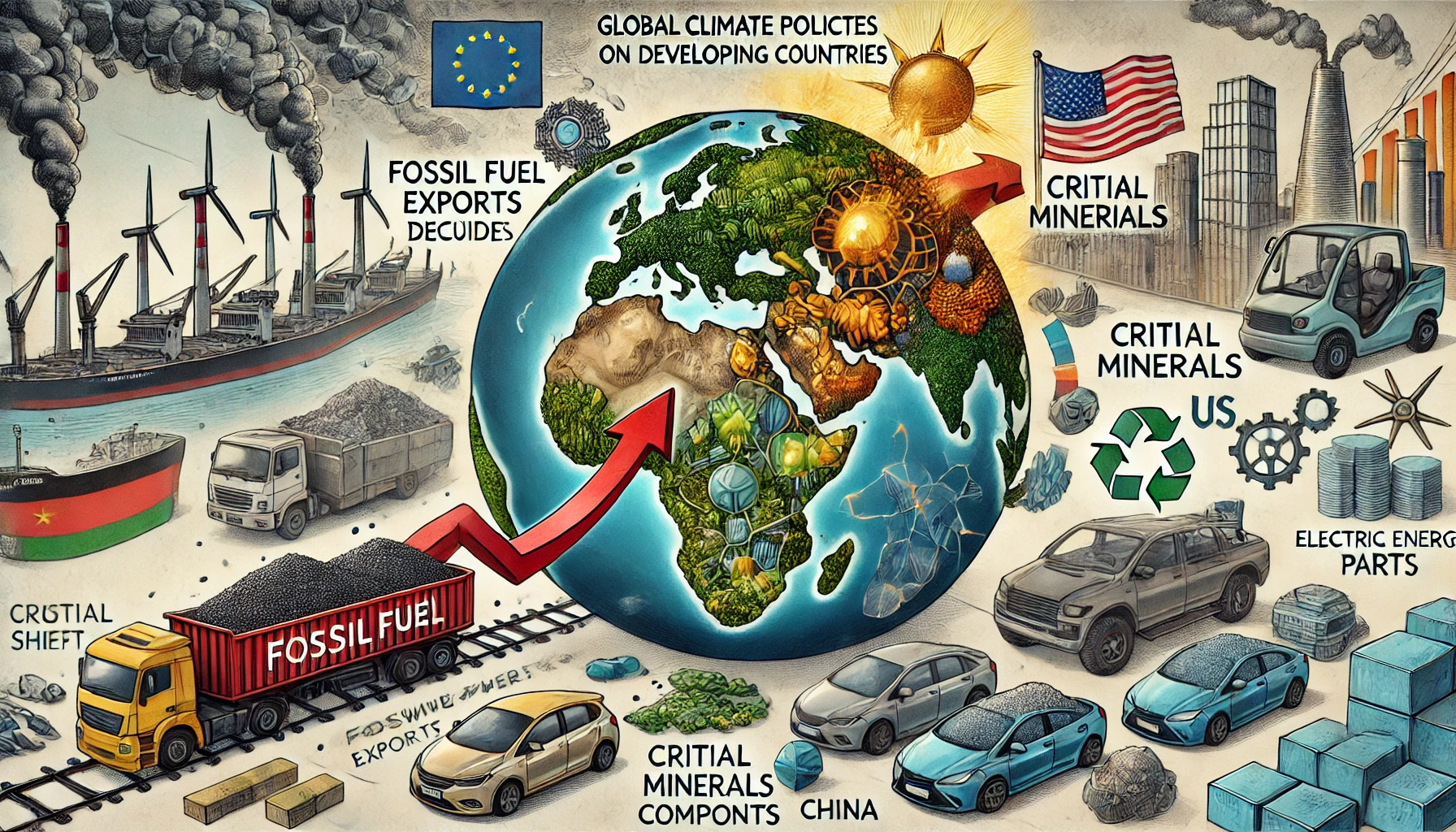Green Transition Gains and Risks: How Climate Policies Reshape Developing Nations’ Trade
The World Bank study highlights how climate policies from the EU, US, and China reshape global trade, reducing demand for fossil fuels while creating opportunities in green transition sectors like critical minerals and renewable energy. Developing countries must navigate trade risks, compliance costs, and policy barriers to capitalize on these shifts.

Researchers from the Economic Policy Global Department at the World Bank have examined how climate policies from the European Union (EU), United States (US), and China reshape global trade and economic development, especially in developing nations. These policies, aimed at reducing greenhouse gas emissions, vary significantly in design but collectively influence international markets. The EU employs carbon pricing mechanisms such as the Emissions Trading System (ETS) and the Carbon Border Adjustment Mechanism (CBAM). The US leverages subsidies under the Inflation Reduction Act (IRA) to promote clean energy and diversify critical mineral supply chains. Meanwhile, China prioritizes regulatory measures, large-scale infrastructure investments, and an intensity-based ETS. These diverse approaches have far-reaching implications for developing countries, impacting trade dynamics, global pricing, and access to green technologies.
Winners and Losers in Fossil Fuel Trade
The policies are likely to reduce global demand for fossil fuels and energy-intensive products, creating vulnerabilities for exporters reliant on these sectors. Oil-dependent economies such as Libya, Angola, and Azerbaijan face significant risks, as fossil fuel exports to the EU, US, and China represent large portions of their GDP. Countries like Mongolia, which export coal and gas primarily to China, may also experience declining revenues as China’s ETS expands. The CBAM poses an additional challenge for energy-intensive exporters like Mozambique and Zimbabwe by imposing carbon-linked costs that threaten their competitiveness in the EU market. However, nations with lower carbon production footprints, such as Albania and Colombia, may capitalize on opportunities to expand their exports to environmentally conscious markets.
Agriculture and Industry Under New Regulations
Agriculture and forestry sectors in developing nations are under pressure from stringent policies like the EU Deforestation Regulation, which mandates rigorous traceability and compliance with environmental standards. Countries such as Côte d’Ivoire and São Tomé and Príncipe, whose agricultural exports rely heavily on EU markets, face high compliance costs, potentially squeezing smallholder farmers. In textiles, nations like Bosnia and Herzegovina and Ethiopia are also significantly exposed to EU regulations, given their reliance on EU trade. Meeting these regulatory demands will require substantial investment in infrastructure, certification processes, and green technologies to ensure that developing countries remain competitive.
Critical Minerals and the Green Transition
The rising global demand for critical minerals, fueled by the green energy transition, offers significant opportunities for resource-rich nations. Minerals like lithium, cobalt, and nickel essential for electric vehicles (EVs) and battery production—are in higher demand due to climate policies. Countries like the Democratic Republic of Congo, Mozambique, and Indonesia are well-positioned to benefit. However, stringent sourcing requirements under the IRA and the EU’s Critical Raw Materials Act may favor nations with trade agreements or sustainable practices, sidelining dominant suppliers like China and Chile. Developing countries with significant reserves must not only scale up production but also ensure adherence to international sustainability standards to capitalize on these opportunities.
Electric Vehicles and Renewable Energy Opportunities
Policies encouraging EV adoption and renewable energy, such as the EU’s zero-emission vehicle standards and the IRA’s clean energy incentives, are driving demand for green technologies and components. Developing countries with established automotive industries, such as Mexico, Morocco, and Türkiye, stand to gain from increased demand for EVs and components. However, the IRA’s local content rules may limit market access for non-domestic producers of EV batteries and components, redirecting investments to North America. Renewable energy technologies also present growth opportunities for countries like Bosnia and Herzegovina and Tunisia, which export solar and wind energy components. Yet, these nations must align industrial policies with evolving international standards to remain competitive.
While the green transition sectors present growth opportunities, protectionist measures such as domestic content requirements and industrial subsidies risk creating trade distortions. These measures may inhibit the ability of developing countries to participate fully in global value chains, limiting their access to benefits from the green energy transition. Harmonizing carbon standards and streamlining compliance procedures through international cooperation will be essential to mitigating these risks and fostering an equitable transition. Developed nations must also facilitate the transfer of green technologies to developing countries, enabling them to meet regulatory requirements and integrate into global markets.
Developing countries must adopt proactive strategies to navigate these changes. Implementing carbon pricing mechanisms, fostering renewable energy industries, and improving monitoring and compliance infrastructure are critical steps. Countries should prioritize value addition in sectors such as critical minerals and green technology manufacturing while supporting small and medium enterprises to meet international environmental standards. Financial and technical assistance from advanced economies can help developing nations address these challenges and leverage the opportunities presented by climate policies.
Navigating the Complex Path Ahead
The World Bank analysis highlights the transformative potential of climate policies from the EU, the US, and China, emphasizing their dual impact of driving a global green transition while creating new complexities for developing countries. These policies could reshape global trade, reduce carbon emissions, and foster innovation, but their implementation must be carefully managed to prevent exacerbating inequalities and trade disruptions. International cooperation to harmonize standards, reduce trade barriers, and share technology will be critical in ensuring that the benefits of a low-carbon economy are accessible to all.
For developing countries, the stakes are high, but so are the opportunities. With the right mix of domestic policies, strategic international partnerships, and targeted investments, they can turn challenges into avenues for sustainable economic growth. The green transition is not just an environmental imperative; it is also an economic opportunity to foster resilience and inclusivity in the global economy. As the world moves toward a low-carbon future, developing countries have a pivotal role to play in shaping a more sustainable and equitable global trading system.
- FIRST PUBLISHED IN:
- Devdiscourse










